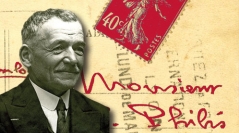

 Geodiversitas
44 (11) - Pages 321-383
Geodiversitas
44 (11) - Pages 321-383In natural history museums and other institutions, fossil collections are the treasures of paleontologists. They are the conservatories of the living world of geological times. It is important for paleontologists to know the history of the collections they consult for various reasons, whether to compare new discoveries with already known fossils or to review the systematics of a group of organisms or a lineage. In the present study we are interested in the history of certain collections of fossil mammals at the natural history museums of Paris, Lyon and Basel, as well as at the University Claude Bernard-Lyon I. Behind these collections is a peasant from Auvergne, Pierre Philis, whom Pierre Teilhard de Chardin called “fossil hunter” in a letter addressed to Professor Marcellin Boule in 1921, when he was commissioned by Boule to meet him. P. Philis was born in 1880 at the hamlet of Senèze, commune of Domeyrat in Haute-Loire. He has extracted from the subsoil of his land, but also from other sites in several other regions of France, countless fossil mammals that make today the richness of these museums and other institutions. It was probably when he saw two scholars from Paris (M. Boule and A. Gaudry), accompanied by local notables, coming in 1892 to dig up huge bones of a mammoth in a field of his village that he must have get passionate about finding fossil animals. From the beginning of the 1900s, he devoted all his free time to undertake excavations on his lands at Senèze and offered to sell the fruit of his record to paleontologists from various European countries. From then on, a continuous correspondence started between P. Philis and his interlocutors, in particular with the most famous paleontologists of the first half of the 20th century: M. Boule and P. Teilhard de Chardin in Paris; C. Depéret, C. Gaillard, F. Roman and L. Mayet in Lyon; H. G. Stehlin, S. Schaub and H. Helbing in Basel. For 35 years, from 1907 until his death in 1942, P. Philis had a rich exchange that went far beyond the simple relations between collector and buyers. We had access to 1,300 letters and postcards and about forty documents of various kinds, totally unpublished, kept in family or institutional archives. The collections of the Paris Museum, the Musée des Confluences and the University Claude Bernard in Lyon and the Naturhistoriche Museum in Basel keep several thousand specimens of fossil mammals collected by P. Philis at Senèze but also in many other localities in the departments of Haute-Loire, Puy-de Dôme, Gard and Vaucluse. These collections include many complete skeletons, some of which are still on display in the permanent exhibition halls of these museums. P. Philis also praised his services and his digging knowledge to his interlocutors, to go prospecting and digging where his sponsors sent him: Chilhac, Soleilhac, Sainzelles, Vialette, Ronzon (Haute-Loire), Les Étouaires, Rocca-Neyra, Mont-Doury, Chambezon (Puy-de-Dôme), Euzet-les-Bains, Souvignargues (Gard), Murs (Vaucluse), etc. The search for human fossils and especially of « Tertiary Man » was in everyone’s mind at the time. P. Philis participated by discovering a skull of Paradolichopithecus at Senèze, by digging trenches at La Denise (Haute-Loire). He was also an intermediary between amateur collectors and major museums for the acquisition of collections. But the sale of fossils to the highest bidders and the export of this heritage outside the region and abroad were not appreciated by all. Some have not hesitated to criticize him in their writings or to denounce his activity to the authorities. In the 1910s, several law projects related to the regulation of prehistoric and paleontological excavations and in particular to the trade of fossils and archaeological objects and their export abroad reacted C. Depéret and trembled the Basel paleontologists. But these law projects did not result in any regulation of the excavations, and until the end of his life, P. Philis excavated and sold tons of vertebrate fossils to his correspondents. Did Philis search only to earn money to supplement his farm income by selling fossils and / or by hiring his services for excavation? Certainly not. By digging for fossils, he had the recognition of great scholars of his time who dedicated new species to him. He was appointed Academy Officer and received the honors of the Republic. Beyond that, he satiated a real passion for the paleontology of mammals. It is these and many other aspects that we have tried to develop in this work. We followed Philis’ footsteps wherever he went to look for fossils, and through his correspondence the evolution of his knowledge and his passion for the paleontology of fossil mammals. We have read his correspondence with paleontologists, tried to highlight the competition between laboratories in Paris, Lyon and Basel, taking into account the scientific context of the first half of the 20th century. P. Philis, this peasant from Haute-Loire, was in fact a great actor of his time for the paleontology of mammals and the father of many collections in several institutions.
Pierre Philis, mammals, Plio-Pleistocene, Auvergne, excavation, history, correspondence, collections, legislation